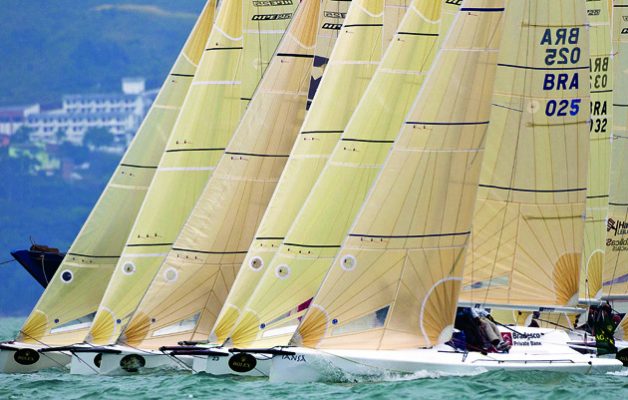“We need to find a lane out of here,” but where to go? Jonty Sherwill asked J/24 World Champion Ian Southworth for his tips on finding a clear lane through the traffic
For the leading boats clear air comes free, but for those locked in the middle of a competitive fleet this essential commodity is in short supply.
Whether it was a poor start, taking the wrong side on the previous leg or a sloppy spinnaker drop, it’s all too easy to find yourself in traffic and with extra work to do.
“We need to find a lane out of here” is the message coming from the rail, but will a rushed tack away help the situation or just put you straight back into more dirty air? Your boat speed is now quite low and you know a tack could put you at the mercy of approaching starboard boats so maybe keeping going even with those boats close to windward will be safer.
This scenario will be a familiar one to most club sailors – just part of an average day – but it is noticeable that when the hotshots drop back into the pack they are seldom there for long. That may leave you wondering how they have the knack of salvaging a result from what to you seemed a hopeless situation.
So what is the best strategy for recovery, and where was that mythical clear lane that could have helped you grasp a chance of recovery, or even fast tracked you up to the leading pack? Was it one lane you were looking for or a series of lanes?
Battling it out in the middle of the fleet is always hard so trusting your judgement and going round the outside is worth considering, but avoid panic decisions and stick to your tried and tested system of crew roles and responsibilities. That way you can enjoy the team game of digging yourselves out of trouble in the knowledge that there will be others making far bigger mistakes than what got you where you are right now.
But if arriving at the top mark near the back of the fleet is getting too hard to bear, it’s time to get some expert advice.
1. Finding a lane
Lanes are areas of relatively undisturbed air that are not being decelerated or disturbed by sails. The skill to develop is finding a lane that won’t be taken away from you by another boat, or at least not for a while.

Lanes move across the course depending on where boats are going and become blocked when another boat to windward tacks and takes that lane. That boat will now be in clear air and you will now be in their dirty air and looking for a fresh lane on the other tack.
2. Don’t just sit there
Finding yourself down the pan is tough, but the first thing is to be aware of whether you are in a lane of clear air or in dirty air. Half the calls about being in dirty air are incorrect in my experience so look carefully at the windex of the boat or boats to windward to see if you are being affected by them, before speaking up.
If the effect is only slight and those boats are going the right way on the course, staying with them may be a lot better than tacking away. But if you are in heavy cover get out of there fast – there will be opportunities elsewhere.
3. Visualise where you want to go
Decide who in your crew will be tasked with picking lanes – ideally it should be the person in the best position for good visibility. In the J/24 I do that job from the helm, but it depends on the type of boat you’re sailing.
Visualise what the boats ahead will be doing and keep looking for the best wind and windshifts. On downwind legs keep a watchful eye astern to stay in a clear lane, and if you are behind you will have a better overall view to help you decide your tactic for the leg.
4.Think strategy
Think as far ahead as possible and plan where you would like to be. Stay in phase with the leading pack by tacking below them in clear air. That way boats crossing on the other tack are less likely to tack on you as they will be dirty air themselves.
If that happens stay calm and assess whether sailing fast and free or tacking away will give you the best position to make the next gain.
5. Light and heavy airs options
The lighter the breeze, the lighter it gets in the middle of the fleet, so getting out to the corners should give you stronger, less disturbed air to sail in.
There will be other boats ahead of you doing the same thing so sailing well beyond the layline for the weather mark can avoid others tacking on you and allow you to sail fast for the mark.
In a stronger breeze it might well be better to tack somewhat short of the layline to give you more options to find lanes as you approach the mark.
Ian Southworth recorded numerous titles in the Enterprise, GP14 and Lark dinghy classes between 1976 and 1982 and won the Champion of Champions Endeavour trophy three times. He also raced in the 470 class, was 3rd at the Nation’s Cup in 1991, European 18 foot Skiff Champion in 1997 and was 3rd at the Worlds a year later. In the J/24 class he was three times British Champion, European Champion and in 2015 won the J/24 World Championship




